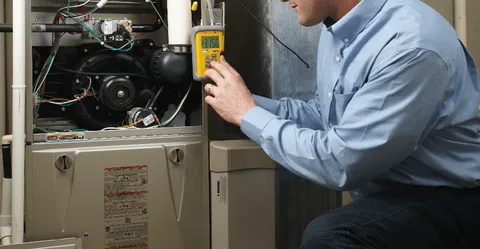
A furnace is a crucial part of your home’s heating system, ensuring that your space stays warm during the colder months. However, like any appliance, furnaces have a limited lifespan and may need to be replaced over time. Recognizing the signs that your furnace needs installation or replacement can save you from unexpected breakdowns and costly repairs. In this article, we’ll discuss the key signs that indicate it may be time to replace your furnace.
1. Your Furnace Is Over 15 Years Old
Age Is a Major Factor
The average lifespan of a furnace is around 15 to 20 years. As your furnace ages, its efficiency declines, and it becomes more prone to breakdowns. If your furnace is older than 15 years, it might be more cost-effective to replace it rather than continue to repair it.
Why Replace?
- Older furnaces lose efficiency, leading to higher energy bills.
- Parts become harder to find, making repairs more expensive.
- Newer models are often significantly more energy-efficient.
2. Your Energy Bills Have Increased
Rising Costs
If you’ve noticed a steady increase in your energy bills without a corresponding increase in usage, it could indicate that your furnace is losing efficiency. Over time, older furnaces have to work harder to maintain the same level of heating, which can lead to higher energy consumption and bills.
Why This Happens:
- Older furnaces require more energy to heat your home.
- Worn-out parts, such as the blower or heat exchanger, can increase energy usage.
3. Frequent Repairs and Breakdowns
Constant Repairs
If your furnace frequently requires repairs or if you’ve had multiple costly repairs in the last few years, it may be a sign that your furnace is near the end of its life. While minor repairs are normal, ongoing issues may indicate that the furnace is failing and replacement is a better option.
Common Problems:
- Broken parts like the blower motor or heat exchanger.
- Frequent ignition or pilot light issues.
- Malfunctioning thermostat or wiring.
4. Uneven Heating or Cold Spots
Inconsistent Temperature
If certain rooms in your home are much colder than others, it may be a sign that your furnace is no longer distributing heat evenly. Uneven heating could also be caused by blocked ducts, but if you’ve already cleaned the ducts and the issue persists, your furnace might be the culprit.
Possible Causes:
- A malfunctioning blower motor.
- Worn-out components that prevent consistent airflow.
5. Strange Noises Coming From the Furnace
Unusual Sounds
A well-functioning furnace should operate quietly. If you hear unusual noises like banging, popping, squealing, or rattling, it could indicate that there’s a mechanical issue. These sounds often signal worn-out or broken parts that might need replacement.
Common Noises:
- Banging or popping: Could indicate problems with the ductwork or gas combustion.
- Squealing or whining: Often caused by worn-out bearings or belts.
6. The Furnace Is Cycling On and Off Frequently
Short Cycling
Short cycling refers to the furnace turning on and off repeatedly in short bursts. This is a sign that the furnace is not operating properly and could be a result of problems like a malfunctioning thermostat, dirty filters, or issues with the flame sensor.
Why It Happens:
- Overheating due to clogged filters or malfunctioning parts.
- Faulty thermostats or improper calibration.
7. Excessive Dust and Dry Air
Poor Air Quality
If you notice an increase in the amount of dust circulating through your home, or if the air feels unusually dry, it could indicate that your furnace is not working efficiently. An inefficient furnace often struggles to filter out dust and humidity, affecting the air quality in your home.
Causes:
- Dirty filters that aren’t trapping dust properly.
- Poor humidity control or lack of a humidifier in your system.
8. Yellow or Flickering Pilot Light
Pilot Light Issues
If the pilot light on your furnace is yellow or flickering instead of a steady blue flame, it can indicate that the furnace is not burning fuel efficiently. This can be a sign of a problem with the gas valve, burner, or heat exchanger, which may require replacing the furnace.
Other Potential Causes:
- A malfunctioning thermocouple.
- Blocked venting, which can cause combustion issues.
9. Furnace Frequently Runs, but Doesn’t Heat Effectively
Inconsistent Heating
If your furnace runs for long periods but doesn’t heat your home adequately, it could indicate that the furnace is struggling to meet the demands. This can happen as a result of aging parts, insufficient fuel, or issues with the heat exchanger.
Why This Happens:
- The furnace is worn out and can no longer provide consistent heat.
- Problems with the blower motor or heat exchanger that prevent effective heating.
10. You Are Spending More on Repairs Than on Replacement
Cost of Repair vs. Replacement
If the cost of repairing your furnace exceeds half of what it would cost to replace it, it may make more sense to invest in a new system. Ongoing repairs can add up quickly, and replacing the furnace with a new, more energy-efficient model could provide better long-term savings.
Consider Replacement If:
- The furnace is over 10-15 years old.
- Repairs are costly and frequent.
- You want to upgrade to a more energy-efficient system.
Conclusion
Furnace installation or replacement is an important decision that can significantly impact your home’s comfort, energy efficiency, and safety. If your furnace is showing signs of age, such as increased energy bills, frequent repairs, or uneven heating, it may be time to replace it. A new furnace will not only improve comfort and air quality but will also provide long-term savings through greater energy efficiency. If you notice any of the signs mentioned above, consult with a professional HVAC technician to evaluate whether it’s time to replace your furnace and choose a system that meets your home’s heating needs.
FAQs
1. How do I know if I need to replace my furnace?
Signs include frequent repairs, rising energy bills, uneven heating, strange noises, or if the furnace is over 15 years old.
2. What is the lifespan of a furnace?
The average lifespan of a furnace is about 15-20 years. If your furnace is older, it may be time for a replacement.
3. How can I improve furnace efficiency before replacing it?
Regular maintenance, changing filters, and ensuring proper insulation can improve efficiency, but replacing an old furnace may still be the best option for long-term savings.
4. How often should I replace my furnace?
You should replace your furnace if it is more than 15 years old, experiencing frequent breakdowns, or costing more to repair than replace.
5. Is it worth replacing an old furnace?
Yes, upgrading to a new furnace can significantly lower your energy bills and improve comfort, especially if your current furnace is inefficient or outdated.




